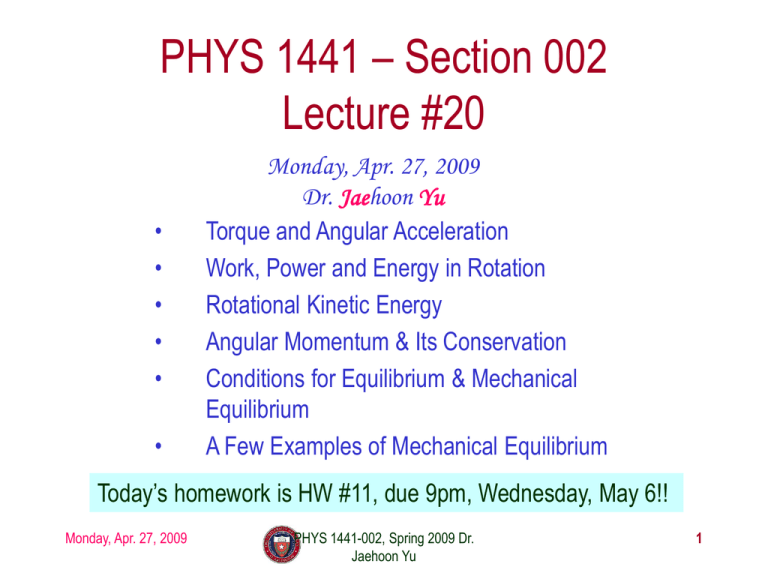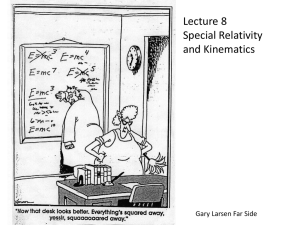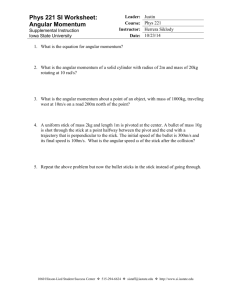Monday, April 27 , 2009
advertisement

PHYS 1441 – Section 002 Lecture #20 • • • • • • Monday, Apr. 27, 2009 Dr. Jaehoon Yu Torque and Angular Acceleration Work, Power and Energy in Rotation Rotational Kinetic Energy Angular Momentum & Its Conservation Conditions for Equilibrium & Mechanical Equilibrium A Few Examples of Mechanical Equilibrium Today’s homework is HW #11, due 9pm, Wednesday, May 6!! Monday, Apr. 27, 2009 PHYS 1441-002, Spring 2009 Dr. Jaehoon Yu 1 Announcements • Term exam resolution – There will be another exam for those of you who wants to take in the class 1 – 2:20pm this Wednesday, Apr. 25 • You are welcome to take it again but – If you take this exam despite the fact you took last Wednesday, the grade from this exam will replace the one from last Wednesday’s – It will cover the same chapters and will be at the same level of difficulties – The policy of one better of the two term exams will be used for final grading will still be valid • The final exam – Date and time: 11am – 12:30pm, Monday, May 11 – Comprehensive exam – Covers: Ch 1.1 – What we finish next Monday, May 4 Monday, Apr. 27, 2009 1441-002, Spring 2009 Dr. 2 – There will be a help PHYS session Wednesday, May 6, during the class Jaehoon Yu Torque & Angular Acceleration Ft r F r Let’s consider a point object with mass m rotating on a circle. What forces do you see in this motion? m The tangential force Ft and the radial force Fr Ft mat mr The torque due to tangential force Ft is Ft r mat r mr 2 I The tangential force Ft is What do you see from the above relationship? What does this mean? I Torque acting on a particle is proportional to the angular acceleration. What law do you see from this relationship? Analogs to Newton’s 2nd law of motion in rotation. How about a rigid object? The external tangential force dFt is d Ft d mat d mr dFt 2 r d m d F r d The torque due to tangential force F is t t dm The total torque is d r 2d m I r Contribution from radial force is 0, because its What is the contribution due line of action passes through the pivoting O to radial force and why? point, making the moment arm 0. Monday, Apr. 27, 2009 PHYS 1441-002, Spring 2009 Dr. 3 Jaehoon Yu Ex. 12 Hosting a Crate The combined moment of inertia of the dual pulley is 50.0 kg·m2. The crate weighs 4420 N. A tension of 2150 N is maintained in the cable attached to the motor. Find the angular acceleration of the dual pulley. mg ma F T y y 2 T2' mg ma y ' T T 11 2 2 T1 1 mg ma y since ay Solve for 2 T mg 1 1 I m 22 Monday, Apr. 27, 2009 2 I T1 1 mg m 2 2 2 I 2150 N 0.600 m 451 kg 9.80 m s 2 0.200 m 6.3rad 2 2 46.0 kg m 451 kg 0.200 m PHYS 1441-002, Spring 2009 Dr. Jaehoon Yu 4 s2 Work, Power, and Energy in Rotation Let’s consider the motion of a rigid body with a single external force F exerting tangentially, moving the object by s. The rotational work done by the force F as the object rotates through the distance s=rq is W Fs Frq W Frq q Since the magnitude of torque is rF, What is the unit of the rotational work? J (Joules) The rate of work, or power, of the constant torque becomes P What is the unit of the rotational power? Monday, Apr. 27, 2009 W q t t How was the power defined in linear motion? J/s or W (watts) PHYS 1441-002, Spring 2009 Dr. Jaehoon Yu 5 Rotational Kinetic Energy y vi mi ri q O x What do you think the kinetic energy of a rigid object that is undergoing a circular motion is? 1 1 2 2 m v Kinetic energy of a masslet, mi, Ki m r i Ti i i 2 2 moving at a tangential speed, vi, is Since a rigid body is a collection of masslets, the total kinetic energy of the rigid object is 1 1 2 2 KER Ki mi ri mi ri 2 i 2 i i Since moment of Inertia, I, is defined as I mi ri 2 i The above expression is simplified as Monday, Apr. 27, 2009 1 KER I 2 PHYS 1441-002, Spring 2009 Dr. Jaehoon Yu Unit? 6 J Ex. 13 Rolling Cylinders A thin-walled hollow cylinder (mass = mh, radius = rh) and a solid cylinder (mass = ms, radius = rs) start from rest at the top of an incline. Determine which cylinder has the greatest translational speed upon reaching the bottom. Total Mechanical Energy = KE+ KER+ PE 2 2 E 12 mv 12 I mgh From Energy Conservation 1 2 mv I mghi 2 f Solve for vf 1 2 2 f 2mgho vf m I r2 The final speeds of the cylinders are v hf s v Monday, Apr. 27, 2009 f 1 2 mv2f 12 I 2f mgh f 12 mvi2 122 I i2 mgh0 since f vf r What does this tell you? 2mgho m Ih r 2 1 2 mv 2 f 1 2 I vf r 2 mgh0 The cylinder with the smaller moment of inertia will have a greater final translational speed. 2mgho m mrh2 rh2 2mgho 2m 2mgho 2mgho 2mgho 1441-002, 2009 1 2 Spring 2 Dr. m I h r 2 PHYS 2 m Jaehoon mrh rh Yu m 2 3 gho 3 3 gho v hf 1.15vhf 2 2 7 Kinetic Energy of a Rolling Sphere Let’s consider a sphere with radius R rolling down the hill without slipping. R h q vCM Since vCM=R What is the speed of the CM in terms of known quantities and how do you find this out? 1 1 2 2 2 K I CM MR 2 2 2 1 vCM 1 Mv 2 I CM CM 2 2 R 1I 2 CM2 M vCM 2 R Since the kinetic energy at the bottom of the hill must be equal to the potential energy at the top of the hill 1 I CM 2 M 2 vCM Mgh K 2 R vCM Monday, Apr. 27, 2009 PHYS 1441-002, Spring 2009 Dr. Jaehoon Yu 2 gh 1 I CM / MR 2 8 Example for Rolling Kinetic Energy For solid sphere as shown in the figure, calculate the linear speed of the CM at the bottom of the hill and the magnitude of linear acceleration of the CM. Solve this problem using Newton’s second law, the dynamic method. What are the forces involved in this motion? Gravitational Force, Frictional Force, Normal Force Newton’s second law applied to the CM gives n f M h Mg F F q x Mg sin q f MaCM y n Mg cosq 0 Since the forces Mg and n go through the CM, their moment arm is 0 and do not contribute to torque, while the static friction f causes torque CM We know that I CM 2 MR 2 5 aCM R Monday, Apr. 27, 2009 We obtain fR I CM 2 MR 2 I CM 2 f aCM MaCM 5 R R R 5 Substituting f in dynamic equations 7 Mg sin q MaCM 5 PHYS 1441-002, Spring 2009 Dr. Jaehoon Yu aCM 5 g sin q 7 9 Angular Momentum of a Particle If you grab onto a pole while running, your body will rotate about the pole, gaining angular momentum. We’ve used the linear momentum to solve physical problems with linear motions, the angular momentum will do the same for rotational motions. Let’s consider a point-like object ( particle) with mass m located at the vector location r and moving with linear velocity v u r r ur The angular momentum L of this L r p sin particle relative to the origin O is What is the unit and dimension of angular momentum? Note that L depends on origin O. Why? kg m2 / s [ ML2T 1 ] Because r changes What else do you learn? The direction of L is +z Since p is mv, the magnitude of L becomes L mvr mr 2 I What do you learn from this? If the direction of linear velocity points to the origin of rotation, the particle does not have any angular momentum. If the linear velocity is perpendicular to position vector, the particle moves exactly the same way as a point on a rim. Monday, Apr. 27, 2009 PHYS 1441-002, Spring 2009 Dr. Jaehoon Yu 10 Conservation of Angular Momentum Remember under what condition the linear momentum is conserved? ur ur p F 0 Linear momentum is conserved when the net external force is 0. t ur By the same token, the angular momentum of a system is constant in both magnitude and direction, if the resultant external torque acting on the system is 0. What does this mean? p const u r r L ext 0 t ur L const Angular momentum of the system before and after a certain change is the same. r r Li L f constant Three important conservation laws K i U i K f U f r r for isolated system that does not get p p i f affected by external forces r r Li L f Monday, Apr. 27, 2009 PHYS 1441-002, Spring 2009 Dr. Jaehoon Yu Mechanical Energy Linear Momentum Angular Momentum 11 Example for Angular Momentum Conservation A star rotates with a period of 30 days about an axis through its center. After the star undergoes a supernova explosion, the stellar core, which had a radius of 1.0x104km, collapses into a neutron star of radius 3.0km. Determine the period of rotation of the neutron star. What is your guess about the answer? Let’s make some assumptions: The period will be significantly shorter, because its radius got smaller. 1. There is no external torque acting on it 2. The shape remains spherical 3. Its mass remains constant Li L f Using angular momentum conservation I i I f f The angular speed of the star with the period T is Thus I i mri 2 2 f If mrf2 Ti Tf 2 f Monday, Apr. 27, 2009 r f2 2 r i 2 T 2 3 . 0 6 Ti 2 . 7 10 days 0.23s 30 days 4 1 . 0 10 PHYS 1441-002, Spring 2009 Dr. Jaehoon Yu 12 Ex. 14 A Spinning Skater An ice skater is spinning with both arms and a leg outstretched. She pulls her arms and leg inward and her spinning motion changes dramatically. Use the principle of conservation of angular momentum to explain how and why her spinning motion changes. The system of the ice skater does not have any net external torque applied to her. Therefore the angular momentum is conserved for her system. By pulling her arm inward, she reduces the moment of inertia (Smr2) and thus in order to keep the angular momentum the same, her angular speed has to increase. Monday, Apr. 27, 2009 PHYS 1441-002, Spring 2009 Dr. Jaehoon Yu 13 Ex. 15 A Satellite in an Elliptical Orbit A satellite is placed in an elliptical orbit about the earth. Its point of closest approach is 8.37x106m from the center of the earth, and its point of greatest distance is 25.1x106m from the center of the earth. The speed of the satellite at the perigee is 8450 m/s. Find the speed at the apogee. Angular momentum is L I From angular momentum conservation since I mr and 2 Solve for vA v r rP vP vA rA Monday, Apr. 27, 2009 I AA I PP vA 2 vP mr mrP rA rP 2 A 6 8.37 10 m 8450 m s 25.110 m 6 PHYS 1441-002, Spring 2009 Dr. Jaehoon Yu rA v A rP vP 2820 m s 14 Similarity Between Linear and Rotational Motions All physical quantities in linear and rotational motions show striking similarity. Quantities Mass Length of motion Speed Acceleration Force Work Power Momentum Kinetic Energy Monday, Apr. 27, 2009 Linear Mass M Distance r t v a t L v ur r P F v ur r p mv Kinetic I mr 2 Angle q (Radian) q t t ur r Force F ma r r Work W F d K Rotational Moment of Inertia 1 mv 2 2 PHYS 1441-002, Spring 2009 Dr. Jaehoon Yu r ur Torque I Work W q P ur ur L I Rotational KR 1 I 2 2 15 A thought problem • • 1. Moment of Inertia – Hollow cylinder: I mr 2 2. h h – 1 2 3. Solid Cylinder: I s mrs 2 Monday, Apr. 27, 2009 Consider two cylinders – one hollow (mass mh and radius rh) and the other solid (mass ms and radius rs) – on top of an inclined surface of height h0 as shown in the figure. Show mathematically how their final speeds at the bottom of the hill compare in the following cases: Totally frictionless surface With some friction but no energy loss due to the friction With energy loss due to kinetic friction PHYS 1441-002, Spring 2009 Dr. Jaehoon Yu 16




